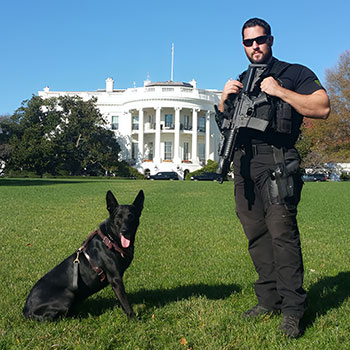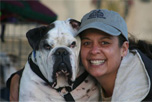Hero Dogs That Protect the President
Maria Goodavage, Secret Service Dogs
 While this might be Trump's second time where there wasn't a pet in the White House, there will still be plenty of dogs involved with Trump's administration, as there have been in all Presidential Administrations since the 1970's. Maria Goodavage has gone on assignment and written a book about these heroes that protect the President of the United States, called Secret Service Dogs.
While this might be Trump's second time where there wasn't a pet in the White House, there will still be plenty of dogs involved with Trump's administration, as there have been in all Presidential Administrations since the 1970's. Maria Goodavage has gone on assignment and written a book about these heroes that protect the President of the United States, called Secret Service Dogs.
The reason no one knows much about these dogs, is because they are Secret Service. This means Maria had to do some digging to find out some fascinating things about them.
During her research, Maria learned that there are actually dogs at almost every layer of protection for the President and Vice-President, as well as their families.
The dogs also protect the White House and visiting dignitaries, such as the Pope. They protect the White House physically, but also by sniffing for explosives, and they go everywhere the President goes.
When it comes to the amount of these dogs in service, Maria explains that is something she cannot disclose. The Secret Service has asked her not to divulge that information for security reasons, but she explains that there are quite a few.
While Trump probably won't have any pets in the White House again, there have been pets in the past, so how do these dogs interact with Presidential Pets? Most are kept separate and the goal is not to have interaction, because you never know how dogs are going to react to each other. Some of these Secret Service Dogs are trained to sniff explosives, while others are trained to protect against anything that could do harm to anyone at the White House, so you don't want one of these pets strolling out and surprising these working dogs. They are able to keep these animals separate because the Secret Service people are in close contact with the White House staff, which let the handlers know when a pet will be outside on the grounds
 But if you know an animal, that doesn't always work. Take for example Barney, President Bush's dog, who was known for escaping from wherever he was supposed to be. Suddenly a Secret Service Dog handler would hear him thundering down the halls of the White House. One time a handler had to pick up his explosive sniffing German Shepherd very quickly while Barney leapt up and grabbed the dog's tail. Fortunately help arrived before anything bad happened to either dog.
But if you know an animal, that doesn't always work. Take for example Barney, President Bush's dog, who was known for escaping from wherever he was supposed to be. Suddenly a Secret Service Dog handler would hear him thundering down the halls of the White House. One time a handler had to pick up his explosive sniffing German Shepherd very quickly while Barney leapt up and grabbed the dog's tail. Fortunately help arrived before anything bad happened to either dog.
Other times. Barney got outside where the tactical dogs were and surprised them. But the handlers are so strong; they were able to hoist their dogs on their shoulders until Barney could be taken away.
Marie explains that the dogs are very high drive and have the same tendencies as other dogs and are also driven by things like prey or balls. In the old days when the program was first started, there was one dog that was fixated on squirrels. After treeing a squirrel one time, that is all he cared about. He no longer cared about protecting the President; it was all about squirrels in trees or squirrels on the ground. So to get him to stop his fixation with squirrels, they got a stuffed toy squirrel and placed hot sauce inside of it. When the dog saw this squirrel, he immediately went for it and caught it victoriously as the hot sauce squirted in his mouth. After that, the dog was no longer in squirrels. Maria explains that that was the only time they did something like that and these days they use positive reinforcement with these dogs and it is all about positive training.
Many of the tactical Secret Service Dogs are Belgian Malinois. They look similar to German Shepherds except they are lighter; more lean and seem to go forever. However, the Secret Service Sniffer dogs are made up of many different breeds, including Labrador Retrievers and Springer Spaniels. These are called the floppy-eared dogs; the friendly dogs. Even though the other dogs are also friendly, these dogs are called friendly because they look friendly because of their floppy ears. This look allows these dogs to get closer to people in crowds enabling them to do a better job at sniffing people for explosives etc.
Wherever the president goes, there will be dogs. They'll be there no matter what the country or state. They'll be there regardless of the political climate, the danger level, the weather, or the hour.
Visit Website
Make Your Pet's Visit To The Vet "Fear Free"
Dr. Kathryn Primm
 A study done by Bayer Animal Health, called the Brakke Study, showed that pet owners claimed that 60-percent of dogs and about 80-percent of cats hated going to the vet.
A study done by Bayer Animal Health, called the Brakke Study, showed that pet owners claimed that 60-percent of dogs and about 80-percent of cats hated going to the vet.
Some of the most obvious signs you'll see if your dog is stressed is shaking, licking, and yawning. Some of the more subtle signs are hardening of the eyes, shifting of weight, or avoiding a glance by butting their head down between their owner's legs. The signs for cats, which are mainly in carriers, are increased respiration, hardening of the eyes and their ears and tail are down.
Veterinary medicine has come a long way with great preventative care, accidents and illnesses, but what was ignored and not even known of its existence right in front of their eyes, was the fear and anxiety of our pets.
However, there is a movement called "Fear Free," developed by "America's Veterinarian," Dr. Marty Becker. The Fear Free initiative aims to "take the 'pet' out of 'petrified'" and get pets back for veterinary visits by promoting considerate approach and gentle control techniques used in calming environments.
Utilization of Fear Free methods and protocols leads to reduction or removal of anxiety triggers, which creates an experience that is rewarding and safer for all involved, including pets, their owners and veterinary health care teams. The end result - calmer, more accepting patients, more compliant clients and better veterinary care.
Dr. Kathryn Primm, Applebrook Animal Hospital in Ooltewah, Tennessee, was the first veterinarian to become a certified Fear Feat Professional. Being Fear Free means that Dr. Prim addresses the patient's fear at every possible opportunity. This includes the trip to her office, the entry into her facility and being placed in an exam room; everywhere where she can perceive there might be a point at which the pet becomes stressed.
 One case example she explains was a client who has a German Shepherd named Bucky. Bucky is an adult dog and was an adult one his first visit to Dr. Primm's office. Before their visit, Dr. Primm had talked to the owner about Fear Free strategies. However, one day Bucky was coming to the clinic for a routine visit. The owner called from her car and said that Bucky was too afraid and she couldn't get him in the facility. Dr. Primm then came outside and talked to the owner and ended up giving Bucky a little bit of an anti-anxiety medication injection. They were then able to complete the exam in its entirety that day, and then reversed the medication. After that, Bucky never had any more stress and doesn't have any bad memories of the Dr. Primm or her facility.
One case example she explains was a client who has a German Shepherd named Bucky. Bucky is an adult dog and was an adult one his first visit to Dr. Primm's office. Before their visit, Dr. Primm had talked to the owner about Fear Free strategies. However, one day Bucky was coming to the clinic for a routine visit. The owner called from her car and said that Bucky was too afraid and she couldn't get him in the facility. Dr. Primm then came outside and talked to the owner and ended up giving Bucky a little bit of an anti-anxiety medication injection. They were then able to complete the exam in its entirety that day, and then reversed the medication. After that, Bucky never had any more stress and doesn't have any bad memories of the Dr. Primm or her facility.
Dr. Primm first leaned of the Fear Free Movement when she heard Dr. Marty Becker speak at meetings. She thought there was a lot of buzz and excitement building up around it. She kept watching the website to see when it was going to live, and as soon as it did, she immediately signed up and started taking the classes.
This would make the life at her animal hospital better for everyone, according to Dr. Primm. The things we dread doing to animals are the same things animals dread having done to them. So it is a positive experience for everyone.
But it doesn't start and stop with the veterinary office. The pet owners also need to be involved and taught to look for subtle clues of an animal that is showing signs of fear and anxiety associated with the visit.
Many owners don't even realize the signs of a stressed animal. Some signs are repeatedly yawning, panting and wagging their tails in a real excited manner. These are not necessarily what they seem. They might be in response to anxiety.
 There are things a pet owner can do at home. For cats, you can purchase a product called Feliway, which is a synthetic pheromone that simulates your cat's natural pheromones to help them cope with stress. There are several brands of pheromones, but they are not all clinically proven to actually work. You can spray this product directly in the kennel to help them relax.
There are things a pet owner can do at home. For cats, you can purchase a product called Feliway, which is a synthetic pheromone that simulates your cat's natural pheromones to help them cope with stress. There are several brands of pheromones, but they are not all clinically proven to actually work. You can spray this product directly in the kennel to help them relax.
Another great idea is to always keep the kennel out. Don't hide it in the closet or the garage and the get it out the morning of the visit. You can even place food or new toys inside.
Follow these tips and ask your vet to make some changes, and you will have a fear-free pet when you visit the vet's. Everyone wins!
All vets are encouraged to become Fear Free Certified by taking an online course.
Visit Fear Free Happy Homes for tips on making your home fear free and to locate a Fear Free Veterinarian near you. Go to Fear Free Pets to become certified.
Listen and Explore the Fear Free Expert Series
Multiple Cats, Stress & Illness - Dr. Debbie
 Caring for one cat is easy. Adding a second or third doesn't take much more work. But how many cats are too many? As the number of cats in a home increase, there is greater risk of behavior and health disorders - partly due to higher stress. Problem behaviors like hissing, chasing and soiling outside the litter box are more common in multi-cat homes. But environmental stress contributes to medical disorders too. That's right - stress will make your cat sick.
Caring for one cat is easy. Adding a second or third doesn't take much more work. But how many cats are too many? As the number of cats in a home increase, there is greater risk of behavior and health disorders - partly due to higher stress. Problem behaviors like hissing, chasing and soiling outside the litter box are more common in multi-cat homes. But environmental stress contributes to medical disorders too. That's right - stress will make your cat sick.
Defining Feline Stress
Crowding within a home zone creates psychological stress for cats. Cats are social creatures, but don't form social structures like dogs or people. They require room to be away from fellow cats and retreat to their own space. But just having more square footage isn't enough. Cats require a multi-dimensional environment with vertical perching sites and hiding spots.
Household activity, changes in the home and the presence of outdoor cats nearby can rile up your cat's stress level. It's easy for cat owners to fail to detect clues of cat stress in the multi-cat household. A majority of cat communication is nonverbal, so even if you don't hear growling or hissing, your cats can be stressed out.
Even mealtime can be stressful. A study of feral cats has shown that cats hunt and eat their prey preferably away from other cats. Feral cats eat up to 10 to 20 times throughout the daytime and night. So kibble offered to pet cats in a large communal bowl once to two times a day is contrary to innate kitty dining behaviors.
Cat Stress = Sickness
Just as in people, the mind-body connection is at work in cats too. Higher stress results in higher levels of compounds that result in bodily inflammation and suppress immune responses.
Feline interstitial cystitis, also referred to as feline idiopathic cystitis (FIC), is an inflammatory problem of the bladder typified by frequent urinations, straining to urinate, and bloody colored urine. The cause of FIC isn't completely known, but stress is believed to contribute to its development. Cat owners are shocked to learn that those bloody urine accidents may have nothing to do with bacteria, and everything to do with stress.
 Other stress related health problems include excess grooming behaviors, obsessive-compulsive behaviors and obesity. Cats in high-density living situations may be prone to upper respiratory outbreaks even if residing solely indoors. Stress and an indoor lifestyle have also been implicated in contributing to obesity, hyperthyroidism, diabetes, and dental disease.
Other stress related health problems include excess grooming behaviors, obsessive-compulsive behaviors and obesity. Cats in high-density living situations may be prone to upper respiratory outbreaks even if residing solely indoors. Stress and an indoor lifestyle have also been implicated in contributing to obesity, hyperthyroidism, diabetes, and dental disease.
What to Do
It's not that you can't have multiple cats, but you need ensure you can provide the environment for more cats. Consider the feline perspective with living space, feeding, and interaction with other animals and people.
Add cats to the home that share similar personalities. A rowdy cat gets along best with other rowdy cats. A timid cat may be stressed out and fail to thrive in a home where fellow cats are outgoing or rambunctious cats.
Work toward household harmony by following the basic guidelines in resources. Provide ample resources to avoid competition, and therefore stress. Provide one more resource than the number of cats in the home. For two cats you should have three litter boxes and three feeding/watering sites.
Vertical height equals safety to cats, so provide ample perching sites for cats, such as cat trees and window perches. Stick to the rule for one more perching site than kitty in the home. Provide hiding spots like paper bags or cardboard boxes.
Promptly address feline behavior problems when they arise by consulting with your veterinarian or a veterinary behaviorist.
For more information on enriching your indoor cat's environment, visit the Indoor Pet Initiative. This resource is provided by the Ohio State University College of Veterinary Medicine.
Featured veterinarian known as "Dr. Debbie" on national pet radio program, Animal Radio. Ebook author of "Yorkshire Terriers: How to Be Your Dog's Best Friend"; "Pugs: How to Be Your Dog's Best Friend"; "Mini Schnauzers: How to Be Your Dog's Best Friend"; and "Shih Tzu: How to Be Your Dog's Best Friend." Dr. Debbie's books.
Visit Website
5 Things Cats Asked Rob & Rob's Answers
Robert Semrow, Listomania
 Alright, so you know how much I love all of the pet holidays and don't think there are nearly enough of them. Well, I've got one for you that proves I and every Grumpy Cat lover out there are right. National Answer your cat's questions day. Yes, it is a real celebration and it's upon us and I thought I would share 5 of the most important or irreverent questions that cats have asked me and share my unfiltered answers with you all - my Animal Radio Friends - who know me and know that cats and I have a unique relationship. Yes, I love cats and cats love cats....
Alright, so you know how much I love all of the pet holidays and don't think there are nearly enough of them. Well, I've got one for you that proves I and every Grumpy Cat lover out there are right. National Answer your cat's questions day. Yes, it is a real celebration and it's upon us and I thought I would share 5 of the most important or irreverent questions that cats have asked me and share my unfiltered answers with you all - my Animal Radio Friends - who know me and know that cats and I have a unique relationship. Yes, I love cats and cats love cats....
Let's begin. A Persian cat once asked me, "Is there really a national answer your cat day?" I replied that there absolutely was, to which he replied - that's ridiculous, everyday is answer your cat day...
I met a Burmese who once asked me if I lived in a tree and had my own scratching post. I told her that I had lots of trees at my house, but no scratching posts. The Burmese told me she knew my type - always with my head in the clouds, chasing the world but forgetting my priorities.
A sphynx once asked me about my obsession with clothes and my ridiculous hair cut. I answered that I wore clothes to stay warm and that my hair was actually short. The Sphynx looked me in the eyes and said - and I Quote, "Your hair isn't short… Get a hair cut hippie and the layered look belongs in the late 90s...." She was right, because Sphynx's are very fashionable.
 Next up was the question that a Bengal asked me about hunting and lasers and if I knew where the catnip was stashed. I told him that I was all for cats with lasers hunting while on the good kind of catnip. We still hang out to this day, unfortunately the lasers gave way to glow sticks and electronic dance music, but as we all know, Bengals got moves. And have you ever just sat and stared at a Bengals beautiful coat and all of the patterns and colors? I have, and that is why I believe Catnip should be legal in all states. Oh wait - Breaking News Cat Nation - Catnip is legal and Cat lasers are just annoying!
Next up was the question that a Bengal asked me about hunting and lasers and if I knew where the catnip was stashed. I told him that I was all for cats with lasers hunting while on the good kind of catnip. We still hang out to this day, unfortunately the lasers gave way to glow sticks and electronic dance music, but as we all know, Bengals got moves. And have you ever just sat and stared at a Bengals beautiful coat and all of the patterns and colors? I have, and that is why I believe Catnip should be legal in all states. Oh wait - Breaking News Cat Nation - Catnip is legal and Cat lasers are just annoying!
Finally, a Savannah cat asked me why I thought it was so cool that they would play in water, walk on leashes and chase balls. I replied that it's fun, it's entertaining and it's… at that point the Savannah got real close and said, "Go Ahead, I dare you to say it....Say it..." I decided that I would email my answer that day as I knew he was begging for me to say, "It's like playing with a dog" As if I would ever say that to a cat, in person. Sorry, have to save that for an upcoming 5 reasons I go to a pet therapist episode. Then again, maybe this was all just a catnip induced dream sequence and cats don't actually talk to me....
Share your Cat Questions and answers on our Animal Radio Facebook Page.
Visit Website
The Dogfather's Grooming Tip with Joey Villani
How To Properly Trim A Dog With A Double Coat
 Joey received a letter from a woman who has a Collie. She has her Collie groomed regularly and is a regular listener. She heard on our show that over time when you trim the coat on a dog like this, or any double-coated dog, sometimes the coat gets thin, which is what is happening to her dog.
Joey received a letter from a woman who has a Collie. She has her Collie groomed regularly and is a regular listener. She heard on our show that over time when you trim the coat on a dog like this, or any double-coated dog, sometimes the coat gets thin, which is what is happening to her dog.
Unfortunately, her groomer has been cutting the dog down, thinking it was going to reduce shedding. However, it does not reduce shedding, the dog just sheds shorter hair that is harder to get out of your carpet and off your furniture and clothing.
This will also damage the coat. In order to get the coat to turn around, there are some things you can do. If you have a Chow Chow or a Pomeranian, their undercoat is light. But if you have a dark colored dog, it sometimes looks strange. You need to then train the coat back and get the natural growth pattern to come back. Joey states the only way to do this is by natural process.
Natural process is this; shedding dogs shed! When you cut them down, this is an unnatural process, which messes up the coat and allows an abundance of undercoat to grow.
 If this happens, you will then need to take the topcoat back and the only way to do this is by brushing and combing, brushing and combing, etc. Unfortunately, in some situations the coat might be too far gone. But usually if you're diligent and you stay on top of it by doing this every single day, (you will pull out a ton of undercoat), you will start noticing a color change. The color will go from light to dark. When you start seeing that dark coat come in, you will know you are making progress. Don't stop - continue what you are doing. Usually in the next couple of, not days or weeks, but months, you are going to start reversing the process.
If this happens, you will then need to take the topcoat back and the only way to do this is by brushing and combing, brushing and combing, etc. Unfortunately, in some situations the coat might be too far gone. But usually if you're diligent and you stay on top of it by doing this every single day, (you will pull out a ton of undercoat), you will start noticing a color change. The color will go from light to dark. When you start seeing that dark coat come in, you will know you are making progress. Don't stop - continue what you are doing. Usually in the next couple of, not days or weeks, but months, you are going to start reversing the process.
You will then have a dog that is not going to shed, is going to look great and be back to normal.
Animal Radio News - Lori Brooks
 Campaign Funds Used For Traveling Bunny
Campaign Funds Used For Traveling Bunny
We've heard of all kinds of campaign spending abuses but this one was a new one. At one point during an investigation of California Representative Duncan Hunter's campaign expenses, the House Office of Congressional Ethics uncovered that the lawmaker had used $600 in campaign funds to cover airfare expenses for his family's rabbit. The government agency said in the report that Duncan had spent $600 in campaign expenditures for in-cabin rabbit transport fees, actually in airline miles. Hunter eventually reimbursed his campaign about $49,000 after a review stated many expenses were inappropriate, including groceries, fast food and items from a trip the lawmaker took to Italy. Use of campaign funds for personal benefit is illegal. In his own defense, Hunter said some of the mis-charges or spending errors happened because the campaign card looked similar to his personal credit card.
 Dream Job Involves Kittens
Dream Job Involves Kittens
This could be the job of your dreams! The ASPCA has a kitten nursery in New York City where staff members and volunteers take care of up to 300 stray and orphan kittens at a time, acting as the kittens' surrogate mothers. They feed them tiny bottles of warmed-up formula and even groom them with a toothbrush, which takes the place of a mother cat's rough tongue. Another task that would be fun to do, and adorable to watch, is blowing bubbles at the kittens as they hone their practice of hunting and pouncing skills. The ASPCA opened the nursery to fill a need because city-run shelters don't have the facilities to care for kittens and end up euthanizing hundreds each year. Kittens come to the nursery as young as one day old, usually through the city shelter system. They are evaluated medically and then spend up to two weeks in quarantine. After they eat on their own, they move to the "peewee" unit, where their keepers prepare them for adoption by getting them used to being handled. At eight weeks, the kittens are neutered and spayed and moved to the adoption center. The nursery is open only during "kitten season" which you may think is just springtime, but it's actually April through November. At the city shelters, kitten euthanasias are down by more than 20 percent.
Pets Benefit The Mentally Ill
There is an ever-growing body of evidence that reinforces the health benefits of animals and it's important that everyone knows the benefits of pets. Hopefully, you've heard about all the physical health benefits of having pets. A study published in BMC Psychiatry sought to explore the role pets had in support, self-management and personal networks of those suffering from long-term significant mental illness (e.g. bipolar disorder, schizophrenia). Their research concluded, "Pets should be considered a main rather than a marginal source of support in the management of long-term mental health problems…" They were asked to rate the importance of those people and things close to them; family members, pets, friends, activities, items, health care team members and so forth. Sixty-percent identified their pet as the most important and felt their pet played a range of positive roles such as helping them to manage stigma associated with their mental health by providing acceptance without judgment. Pets were also considered particularly useful during times of crisis. In this way, pets provided a unique form of validation through unconditional support, which they were often not receiving from other family or social relationships. The positive impact of pets became an immediate calming influence and one that distracted the patient when hearing voices or experiencing unpleasant symptoms. The researchers were balanced in all aspects of the patient and the pet, saying it is also a priority that a plan of care for the animal be included should the patient require hospitalization. Should there be someone in your family with a mental illness that would benefit from a pet, here is the link to the study.
 Rumors That It's Still A Lion
Rumors That It's Still A Lion
A Wisconsin resident's outdoor security camera captured some mysterious feline footage that re-ignited rumors about a "Milwaukee Lion." The man said he received an alert on his phone alerting him to movement detected by the security camera in his back yard, leading him to check the footage. The video revealed what appeared to be a very large cat strolling across his yard. "People gonna say it's like a regular house cat… I've seen house cats on my camera before, and they didn't seem that long or that tall," he said. The footage reignited rumors that stemmed from a previous video that showed what looks like a mountain lion wandering in the neighborhood. Police and the Wisconsin Department of Natural Resources investigated the sighting, but no animal was ever located or positively identified. Despite what the man said, officials said they suspect the animal in the latest video was a common house cat.
 Listen to the entire Podcast of this show (#1310)
Listen to the entire Podcast of this show (#1310)





